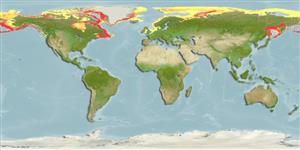Environment: milieu / climate zone / depth range / distribution range
Ecología
marino demersal; rango de profundidad 12 - 930 m (Ref. 58426), usually 125 - 150 m (Ref. 56590). Polar; -2°C - 8°C (Ref. 4698); 84°N - 45°N, 180°W - 180°E (Ref. 117245)
Arctic to Northwest Atlantic: Ungava Bay, Gulf of St. Lawrence in Canada and Greenland; Kara Sea and southeastern part of Barents Sea (Ref. 4698).
Tamaño / Peso / Age
Maturity: Lm ? range ? - ? cm
Max length : 21.0 cm TL macho / no sexado; (Ref. 56590); common length : 12.9 cm TL macho / no sexado; (Ref. 56590); peso máximo publicado: 160.00 g (Ref. 56590); edad máxima reportada: 7 años (Ref. 56590)
Short description
Claves de identificación | Morfología | Morfometría
Espinas dorsales (total) : 8 - 9; Radios blandos dorsales (total) : 18 - 22; Espinas anales: 0; Radios blandos anales: 13 - 18. Young with 2 dark blotches on body, which break up into small dark brown spots in adults; spinous dorsal fin with 1-2 round dark patches, soft part with a few comparatively broad dark stripes; upper part of pectoral fin with transverse stripes; anal and pelvic fins colorless; caudal fin with irregular spots (Ref. 4698).
Found on sand or sandy-mud bottoms with stones with salinities of 24.7-34.2 ppt (Ref. 4698). Benthic (Ref. 58426). Feeds mainly large bottom invertebrates, rarely small mollusks (Ref. 4698).
Life cycle and mating behavior
Maturities | Reproducción | Spawnings | Egg(s) | Fecundities | Larva
Robins, C.R. and G.C. Ray, 1986. A field guide to Atlantic coast fishes of North America. Houghton Mifflin Company, Boston, U.S.A. 354 p. (Ref. 7251)
IUCN Red List Status (Ref. 130435)
Threat to humans
Harmless
Human uses
Herramientas
Special reports
Download XML
Fuentes de Internet
Estimates based on models
Preferred temperature (Ref.
123201): -1.5 - 4.2, mean -0.5 °C (based on 376 cells).
Phylogenetic diversity index (Ref.
82804): PD
50 = 0.5000 [Uniqueness, from 0.5 = low to 2.0 = high].
Bayesian length-weight: a=0.00676 (0.00300 - 0.01523), b=3.17 (2.98 - 3.36), in cm total length, based on LWR estimates for this (Sub)family-body shape (Ref.
93245).
Nivel trófico (Ref.
69278): 3.9 ±0.5 se; based on diet studies.
Resiliencia (Ref.
120179): Medio, población duplicada en un tiempo mínimo de 1.4-4.4 años (Preliminary K or Fecundity.).
Fishing Vulnerability (Ref.
59153): Low vulnerability (11 of 100).
